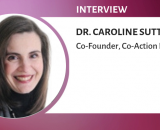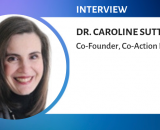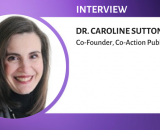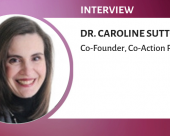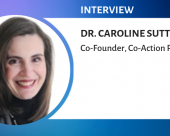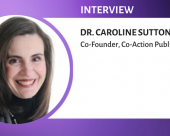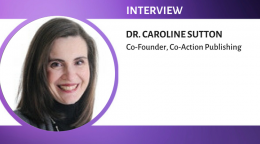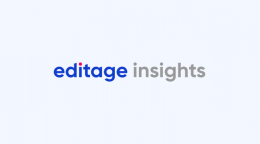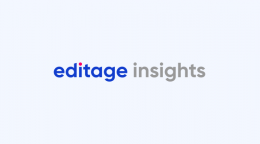Understanding open access publishing and its chances for sustainability
Interview with Dr. Caroline Sutton
This interview series features Dr. Caroline Sutton, Co-Founder of Co-Action Publishing, an open access international academic publishing house that covers a range of disciplines. As an expert on open access publishing, Dr. Sutton dicusses her views and experience regarding scholarly community and open access publishing, such as, the concept of open access, the sustainability of open science, and public debates concerning open access in scholarly communication.

Dr. Caroline Sutton is Co-Founder of Co-Action Publishing, an open access international academic publishing house that covers a range of disciplines. Prior to Co-Action, she served as an Editorial Manager, and later as a Publisher under previous employer, Taylor & Francis (Informa). From 2008 to 2013, she served as the first President of the Open Access Scholarly Publishers Association (OASPA), where currently she is a board member. She is also Director at Infrastructure Services for Open Access (IS4OA), the managing organization of the Directory of Open Access Journal. Some of the other boards Dr. Sutton has previously served on are the board of SPARC Europe (2010 – 2013), the Lund University Library Board (2008 – 2010), the Advisory Board at Linköping University Press, and the Advisory Board for Open Access Publishing in European Networks (OAPEN).
Internationally networked with publishing and library communities, Dr. Sutton is a notable advocate and an active expert on open access publishing: among her many engagements concerning open access, she participated with entities such as the European Commission, where she served as Rapporteur. Dr. Sutton continues to discuss, debate, and work on many projects through Co-Action with leading research groups and figures. She developed the Best Practices Guide to OA Journal Publishing together with Lund University Libraries Main Office. Dr. Sutton holds a PhD in Sociology from Uppsala University, Sweden.
In your view, where is the scholarly community at with open access publishing?
When we launched Co-Action Publishing in February 2007 there were only a few established open access publishers. Together with the other open access publishers, we needed to dedicate a great deal of time to sharing information on what open access publishing was, what a Creative Commons license was, and the difference between gold and green. Funding for open access publications was limited and many established publishers were skeptical, if not hostile, toward open access.
Over the last few years the landscape has changed dramatically. The vast majority of scholarly publishers now have portfolios that include open access titles. Rather than fighting the move towards open access, they have used open access as an opportunity to expand what they offer to researchers. Most large publishing houses have now created “membership” schemes, or similar, such that they can offer bulk payment options to those institutions with a large number of researchers publishing in their journals.
Funding bodies, particularly here in Europe, have increasingly made funding available to cover open access fees, as have a growing number of institutions. An even larger number of funders and institutions have now adopted an open access policy that requires researchers to deposit publications emanating from the funded research in a repository (green) within a specified period of time or to be published in an open access journal (gold). The events that took place in the UK during 2013 alongside the eventual adoption of an open access policy by the European Commission were the most visible of these here in Europe, while in the United States the landmark White House Directive issued by the Office of Science and Technology (OSTP) on February 22, 2013 gave further fuel to the adoption of green policies in North America.
Among the research community, we find a somewhat uneven spread of acceptance and adoption of publishing in open access journals. Cameron Neylon gave a talk in Sweden during 2013 in which he pointed out that the Adoption of Innovation curve that was originally developed by Everett Rogers can help us understand the current state of open access in the scholarly community. Innovators and early adopters, such as the high energy physics community and most of biology, have moved on from talking about open access to publications (this is now a given) and are instead pushing for open access to data and developing tools to enable re-use. On the other hand, we also find an early and late majority for whom simply publishing in open access journals is enough of a shift, albeit one that is now accepted. At the same time, we find a group of laggards for whom open access is, in the best case, a little-understood concept, or in the worst case, an apparent threat.
For open access publishers, particularly those who have been in the game for a long time, the broad adoption of open access publishing within the publishing industry is a welcome turn that offers new challenges. On the one hand, we no longer need to make the argument for open access as strongly as before. On the other hand, the expansion of open access publishing from a small handful of players with a fairly homogenous understanding of what open access entails to a large number of actors, many of whom have brought their own definitions to the table, has led to a somewhat messy marketplace. It was out of this context that the tool How Open Is It? was developed. There are many degrees of ‘open’ along several dimensions. It is important that stakeholders understand what level of open they are demanding or complying with. Alongside a clarification of definitions, we also see that standards and best practices are important to develop in this new environment. In many ways, open access publishing requires an infrastructure that is not yet in place. A great deal of cross-organizational activity and cooperation is directed at developing this new infrastructure.
Many are skeptical of open access because they believe the model is not economically sustainable and could even damage the market if publishing businesses and learned societies experience difficulties due to reduced revenues. Could you please share your thoughts on this?
Currently, there are a number of economic models that are supporting open access journals. For instance, among Co-Action Publishing, there are journals with publication fees, some are fully supported by a society or an institution, and others are currently receiving grants.
In 2013, I took part in a project supported by JISC to develop tools for societies who are considering open access (the tools are available at http://open-access.org.uk/information-and-guidance/guide-to-goldoa/). In conjunction with the project, we interviewed a number of senior people from learned societies and publishing houses, in addition to receiving 250 responses to a survey we distributed among learned societies in the UK. Unsurprisingly, the greatest concern was the financial ramifications of moving to gold or green open access.
First, it should be noted that there are scenarios that suggest a move to gold open access can be both beneficial and financially non-problematic. For small societies who already pay a fair sum of money to a publisher in the form of member subscriptions to the society’s journal, it could be worth exploring the costs of moving the journal to an open access model. Potentially, the society can sustain the journal with the same level of spending or for a slightly higher fee. Societies that are positioned within STM fields of research and are launching a journal for the first time can generally feel confident about launching an open access journal. Societies who own a journal that levy page charges, or fees for color, figures, etc. might find it easier than others to transition as their authors are already familiar with making payments in conjunction with the publication of their articles. The tools found at JISC offer a series of questions that societies ought to consider with respect to this.
Open access is a greater challenge for those societies who manage a highly profitable journal that provides the society with its primary source of income to carry out other activities. A second subset of societies that find open access difficult are those who serve a community that includes a large number of clinicians (who read the journal but do not contribute) and a smaller number of researchers (who contribute content). Finally, where a reduced rate on an official journal is a primary membership benefit, open access can be perceived as a threat. In all of these scenarios, open access forces societies to confront a larger issue – how their activities are funded.
Among other options, we find societies who have chosen to introduce a green open access option to comply with policies, a hybrid option that allows authors a choice, or introduced a second journal with broader aims and scope than the existing journal but which is open access. In 2007, Peter Suber and I collated information on societies with open access journals. This catalogue continues to be curated and developed with assistance from Amanda Page. Currently we list over 850 societies; most societies can find a similar case to their own here at https://docs.google.com/spreadsheet/ccc?key=0AgBYTDKmesh7dDZ6UnBfcnpOdVpnd3ptSnVpQ0xrenc#gid=1.
Watch the second part of this interview series with Dr. Caroline Sutton in which she discusses what reservations authors have about open access journals, how these journals are managing quality peer review, and why blacklisting deceptive journals is not the most useful action the community can take against inappropriate journals.
Published on: Aug 25, 2014
Comments
You're looking to give wings to your academic career and publication journey. We like that!
Why don't we give you complete access! Create a free account and get unlimited access to all resources & a vibrant researcher community.

Subscribe to Journal Selection
After writing a research paper, the next step is to find the right journal to publish it. Subscribe and get curated content to find the perfect journal that will give impetus to your research paper and your career.



